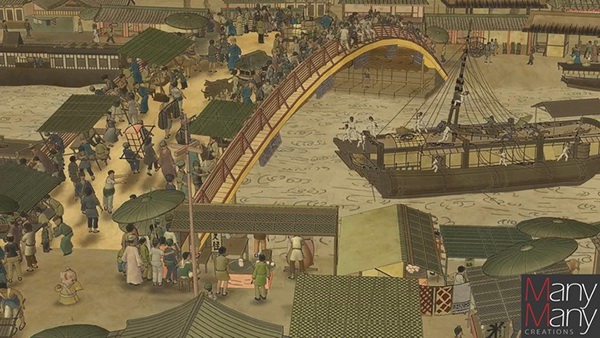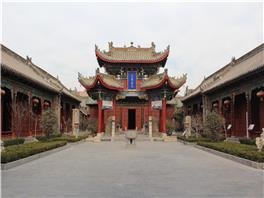

Song Dynasty
he Song Empire arose about 54 years after the large Tang Empire fell in 906. Overall, over the course of 300 years, the empire was prosperous, the population doubled in the 10th and 11th centuries, and science and technology advanced.
Two Equal-Length Eras
The Song Dynasty era is divided almost equally into two time periods called the Northern Song (960–1127) and the Southern Song (1127–1279) eras.
The Northern Song Empire was smaller than the Tang Empire. It didn't control an area of Central Asia that was controlled by the Tang Empire. The Southern Song Empire controlled only about 60 percent of the land area of the Northern Song Empire since the Song clan lost control of the area north of the Huai River.
The Origin of the Song Empire (906–960)
At the end of the the Tang Empire in 906 AD, the territory was divided among kingdoms or was conquered by invaders. Thetime was a period of war and turmoil, and it lasted for about 53 years.
Large sections in the west and north were taken over by other empires or by nomadic tribes, and in the east, there were 8 small kingdoms in 923.
In the year 960, a general in one of the kingdoms called Northern Zhou named Zhao Kuangyin rebelled against his king and the court officials and started his own dynasty.
This general was called Emperor Taizu, and during his lifetime, he went on to defeat most of the kingdoms around him and so established the Song Empire.
The Northern Song Dynasty (960–1127)
 Shanxi Shaanxi Gansu Guildhall in Kaifeng
Shanxi Shaanxi Gansu Guildhall in Kaifeng
Emperor Taizu began reigning in the year 960. His capital was in Kaifeng. During his 16 years of rule, he instituted successful policies and won his wars of expansion.
He is known as one who set the policy that most of the governing officials should be Confucian literati who passed the imperial exam. This stabilized the process of dynastic succession by ensuring that empire's administrative staff could carry on their duties when the emperor died. This policy helped to ensure that the officials were very intelligent, literate, and loyal to the government.
Scientific Academies: He also created academies that allowed a great deal of freedom of discussion and thought. These academies proved successful in later years in nurturing world leading scientists for their times.
The officials were also known for achievement in literature and the arts. Their high level of education helped them formulate policies for trade with other countries and introducing new weapons such as rockets and mortars.
Wars of the Northern Song Dynasty
The Liao Empire in the northeast was a military threat, and the Song court wanted to regain the land of the Western Xia in the northeast. The empire also conflicted with the Viets in the southeast. In various campaigns against these three countries, the Northern Song Dynasty usually lost.
For about 150 years, the result of the Song wars was stalemate. They couldn't conquer their neighbors, but they didn't lose significant territory to them. So they kept their territorial integrity until 1127.
War Against the Western Xia
The Tanguts had a small kingdom called Western Xia in the northwest that controlled access to the strategic Gansu Corridor that was an important link in the Silk Road trade route. The Tangut tribe was a part of the Tang Empire, but they became a kingdom when the Tang Empire disintegrated.
As the Song Empire expanded in the late 900s, they resisted them. The Song Dynasty thought that if they could gain that territory, they could perhaps reestablish the lucrative Silk Road trade that benefited the Han and Tang Dynasties.
The Song Dynasty managed to win several military victories over the Tanguts in the early 11th century. Then a leading scientist and scientific writer named Shen Kuo (1031–1095) who wrote a scientific book called The Dream Pool Essays lead an army against them. This expedition was a disaster, and the Tanguts regained territory they had earlier lost.
War Against the Viets
The Song court wanted to annex the Viet territory. The Ly Dynasty behaved as vassals, but the Song court thought that the country was weak enough to conquer.
In response, the Ly Dynasty sent an army of perhaps 100,000 to Nanning and soundly defeated three Song armies.
From 1075 to 1077, the Ly Dynasty in Vietnam fought them. This war ended in a stalemate also. Captives and captured land were mutually exchanged.
War Against the Liao Empire
The Liao Empire was an aggressive enemy in the northeast. They forced the Northern Song Dynasty to give some tribute in 1005. The Northern Song Dynasty sought to defeat the Liao. They allied themselves with the Jurchens and started a war thatended in their disaster.
The combined armies defeated the Liao Empire, but then the Jurchens turned against the Song Empire and captured Kaifeng that was the Song capital city. They captured the emperor and much of the ruling clan in 1129.
A member of the emperor's clan became the new emperor, and he established a new capital at Hangzhou. The Jurchens madeKaifeng their capital and founded the Jin Empire.
Kaifeng Tours: Two Song era pagodas called Iron Pagoda and Pota Pagoda can be visited in Kaifeng along with other ancient sites.
No comments:
Post a Comment